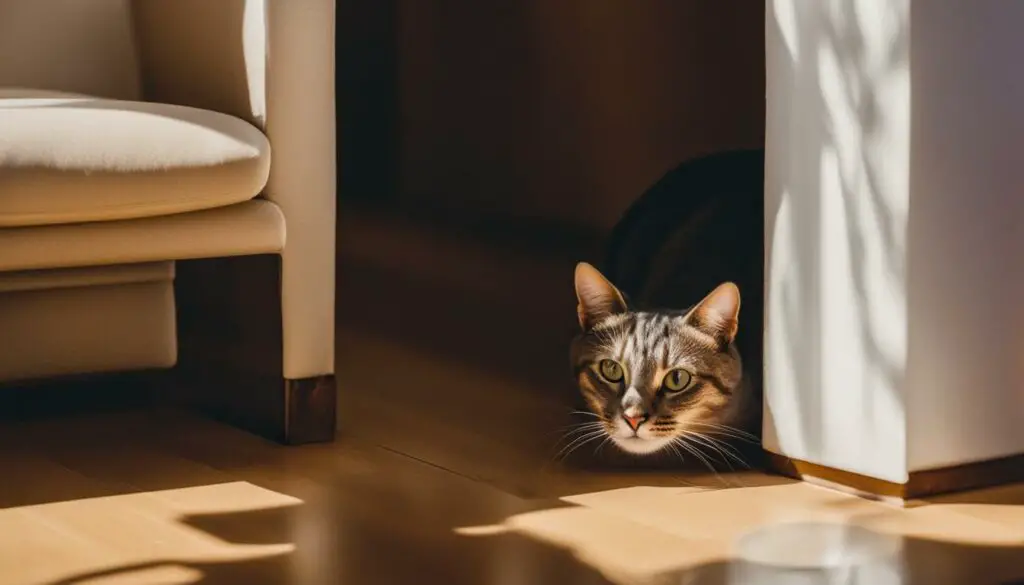Adopting a cat can be overwhelming, especially for a skittish cat. It’s important to approach the process of socializing a shy cat with patience and understanding. The goal is to create a safe and comfortable environment where the cat can gradually build trust and overcome their fear. This guide will provide practical tips and techniques to help your skittish cat feel at home.
Key Takeaways:
- Take it slow and be patient when socializing a skittish cat.
- Create a designated safe space where the cat can feel secure.
- Gradually introduce the cat to new people and pets.
- Use positive reinforcement and engaging playtime to build confidence.
- Learn to read and understand your cat’s body language.
Setting Up a Space: Creating a Safe Haven for Your Skittish Cat
When bringing a skittish cat into your home, creating a designated safe space is crucial for their comfort and well-being. This space should be a quiet and secure area where the cat can retreat and feel protected. Whether it’s a separate room or a corner of a room, providing a safe haven for your skittish cat is essential for reducing fear and anxiety.

Within this safe space, it’s important to provide hiding spots and elevated perches. These hiding spots can include cardboard boxes, cozy beds, or even dedicated cat condos. These areas give your skittish cat a sense of security and allow them to observe their surroundings from a safe distance. Additionally, high perches, such as cat trees or shelves, offer an elevated vantage point that cats naturally seek for comfort and a sense of control.
Furthermore, maintaining a stress-free environment within the designated space is crucial. Ensure that the area is free from potential stressors such as loud noises, crowded spaces, or interactions with other pets. By minimizing potential triggers, you create a calm and peaceful environment that promotes relaxation and reduces fear in your skittish cat.
Creating a Safe Space: Key Considerations
| Factors to Consider | Tips |
|---|---|
| Noise | Avoid placing the safe space near loud appliances or areas with high foot traffic to minimize noise-related stress. |
| Privacy | Ensure the safe space is located in a low-traffic area where your skittish cat can have privacy and feel secure. |
| Access | Provide easy access to food, water, litter box, and toys within the safe space to avoid unnecessary anxiety or stress. |
| Comfort | Offer cozy bedding, comfortable hiding spots, and soft blankets to create a warm and inviting atmosphere. |
By setting up a dedicated safe space, you can create a comforting environment where your skittish cat can feel secure and gradually build trust. This space serves as their sanctuary and allows them to navigate their new surroundings at their own pace, reducing fear and promoting a sense of well-being.
Introductions: Slow and Gentle Approach
When it comes to introducing your skittish cat to new people or other pets, taking a slow and gentle approach is key to building trust and reducing fear. Rushing the process can overwhelm your cat and potentially set back their progress. Instead, give them time to observe from a distance and gradually allow for direct interactions.
Positive reinforcement techniques can be incredibly helpful during introductions. Reward your cat with treats or playtime to create positive associations with new interactions. This will help them feel more comfortable and confident when meeting new individuals or furry friends.
Remember, each cat is unique and may have different comfort levels. Allow your cat to set the pace and gradually increase the level of socialization over time. This gradual approach will not only build trust but also foster a stronger bond between you and your skittish cat.
Positive Food Experiences: Creating a Bond Through Mealtime
When it comes to helping a skittish cat feel more comfortable, positive food experiences can play a crucial role. By creating a positive association with mealtime, you can build trust and strengthen the bond between you and your cat. Here are some tips to create a positive food experience for your skittish cat:
1. Use Food Puzzles or Interactive Toys
Food puzzles or interactive toys can provide mental stimulation for your cat while making mealtime more engaging. These toys encourage your cat to work for their food, which can help alleviate anxiety and reduce fear. They also serve as a distraction, redirecting their focus from any potential stressors in the environment.
2. Consider Calming Pheromones
Using calming pheromone sprays or diffusers near the feeding area can create a relaxing atmosphere for your skittish cat. These pheromones mimic the natural scents that cats release when they feel safe and secure, helping to reduce anxiety during mealtime. This can help your cat associate mealtime with a calm and comfortable environment.
3. Allow Your Cat to Eat at Their Own Pace
Avoid rushing or forcing your cat to eat. Let them eat at their own pace, taking breaks if needed. This allows them to feel in control and reduces the pressure they may feel during mealtime. It’s important to respect their individual eating habits and preferences.

4. Provide a Quiet and Safe Feeding Area
Choose a quiet and undisturbed area for your cat’s feeding spot. This provides them with a sense of security and minimizes any potential sources of stress or anxiety. Keep the feeding area away from loud noises, high-traffic areas, or areas where other pets may disrupt their mealtime.
By implementing these strategies, you can help create a positive and relaxing mealtime experience for your skittish cat. Remember to be patient and consistent in your approach, allowing your cat to gradually build trust and associate mealtime with comfort and security.
Engaging Playtime: Building Confidence Through Play
Playtime is an essential part of socializing a shy cat and helping them feel more comfortable in their new home. By engaging in interactive play, you can not only provide mental and physical stimulation but also build their confidence and reduce anxiety. Here are some cat behavior tips for creating engaging playtime sessions:
- Choose interactive toys: Opt for toys that encourage the cat to engage and interact, such as wand toys or puzzle toys. These toys allow for controlled movements and can be adjusted to match the cat’s comfort level.
- Start with gentle movements: Begin playtime with slow and gentle movements to avoid overwhelming the cat. Gradually increase the level of activity based on their response and comfort level.
- Use positive reinforcement: Reward the cat with treats or praise during and after playtime to create a positive association. This reinforces their confidence and builds trust between you and your skittish cat.
- Be patient and observant: Observe the cat’s body language during playtime. If they show signs of discomfort or stress, such as flattened ears or tense body posture, adjust your approach accordingly and provide them space if needed.
Remember to tailor playtime sessions to your cat’s preferences and limitations. Some cats may prefer shorter and more frequent play sessions, while others may enjoy longer sessions. The key is to provide a safe and engaging environment that allows your skittish cat to explore, have fun, and gradually build their confidence.

Reading Body Language: Understanding Your Cat’s Signals
Understanding your skittish cat’s body language is essential for effectively building trust and reducing fear. Cats communicate their emotions and comfort levels through various physical cues. By learning to interpret these signals, you can adjust your approach and provide the right level of support and comfort for your cat.
Posture: Pay attention to your cat’s overall posture. A relaxed and confident cat will have a relaxed body with their tail held upright. On the other hand, a fearful or anxious cat may crouch low to the ground, tuck their tail between their legs, or flatten their ears against their head.
Tail Movements: The position and movement of your cat’s tail can also provide insight into their emotional state. A slowly swaying tail or a gently vibrating tail is a sign of contentment, while a puffed-up tail indicates fear or aggression. A tail tucked tightly against the body suggests extreme fear or anxiety.
| Body Language | Meaning |
|---|---|
| Ears flattened against the head | Extreme fear or discomfort |
| Purring | Contentment and relaxation |
| Hissing or growling | Signs of fear or aggression |
Vocalizations: Cats use vocalizations to communicate their needs and emotions. While purring generally indicates contentment, hissing, growling, or yowling can be signs of fear, aggression, or distress. Pay attention to the context and accompanying body language to understand the meaning behind your cat’s vocalizations.
By closely observing your skittish cat’s body language, you can gain valuable insights into their emotional state and adjust your approach accordingly. Remember to respect their boundaries, provide a calm and safe environment, and offer positive experiences to help them build trust and overcome their fear.

Gradual Progression: Patience is Key
Socializing a skittish cat takes time and patience. Each cat will progress at their own pace, so it’s important not to rush the process. Allow the cat to dictate the speed of their progress and be prepared for setbacks. Celebrate small victories and provide a supportive environment to encourage further growth and trust-building.
Building trust with a scared cat requires a gradual approach. Start by spending time near the cat’s safe space without imposing direct interaction. Sit quietly and engage in calm activities, such as reading or working on a laptop. This will allow the cat to observe your presence and get familiar with your scent and behavior. Over time, the cat may start to approach and show curiosity. Offer treats or playtime as positive reinforcement for their brave behavior.
As the cat becomes more comfortable, slowly introduce new experiences and social interactions. This can include gentle petting, brushing, or interactive play sessions. Pay close attention to the cat’s body language and cues of discomfort. If they show signs of tension or withdrawal, give them space and try again later. It’s important to respect their boundaries and not force any interactions.
Gentle Approach: key to building trust with a scared cat
Patience is crucial when socializing a shy cat. Many skittish cats have experienced trauma or fear in their past, so it’s essential to create a calm and safe environment. Avoid sudden loud noises or abrupt movements that can startle the cat.
Gradually increase the level of socialization and exposure to new experiences. This may include inviting trusted friends or family members to interact with the cat, or slowly introducing them to other pets in the household. Always supervise these interactions and ensure they are positive and stress-free.
Remember, every cat is unique, and progress may be slow. Be patient and understanding, and don’t push the cat beyond their comfort zone. With time and consistent effort, your skittish cat will gradually build trust and become more confident in their new home.

Gentle Handling: Gradually Building Comfort with Touch
When it comes to helping a skittish cat feel more comfortable, gentle handling and touch play a crucial role. By gradually acclimating your cat to being touched, you can build trust and create a positive association with physical contact. Start with gentle strokes on areas that the cat is comfortable with, such as the head or neck. Observe their response and respect their boundaries at all times.
As your skittish cat becomes more accustomed to gentle touch, gradually extend the contact to other parts of their body. Pay close attention to their body language and never force physical contact. It’s important to let the cat set the pace and only proceed when they are relaxed and receptive.
You can reinforce positive experiences with touch by using treats or praise. This will help create a positive association and further enhance their comfort level. Always remember to be patient, understanding, and gentle in your approach. Building comfort and trust through touch will contribute to your cat’s overall well-being and happiness.
“Gentle touch and handling are essential for helping a skittish cat overcome their fear. Patience and respect for their boundaries will go a long way in building trust and creating a positive bond.” – Me
Table: Building Comfort with Gentle Handling
| Step | Description |
|---|---|
| Start with familiar areas | Gently stroke the cat’s head or neck, where they are more comfortable with touch. |
| Observe their response | Pay close attention to the cat’s body language and ensure they are relaxed and receptive before proceeding. |
| Gradually extend touch | Once the cat is comfortable with head and neck strokes, gradually extend touch to other parts of their body. |
| Use treats or praise | Reinforce positive experiences with touch by offering treats or verbal praise. |
| Respect their boundaries | Always respect the cat’s boundaries and never force physical contact. |
Remember, every cat is unique and will respond differently to touch. Some cats may take longer to feel comfortable, while others may progress more quickly. The key is to be patient, understanding, and consistent in your approach. With time and gentle handling, you can help your skittish cat gradually build comfort and trust.

Desensitization Techniques: Gradually Exposing the Cat to Fearful Stimuli
When it comes to helping a skittish cat overcome fear and anxiety, desensitization techniques can be highly effective. By gradually exposing your cat to the stimuli that trigger fear, you can help them build tolerance and reduce their stress levels. Through patience and a thoughtful approach, you can create a positive association and help your cat feel more comfortable in their environment.
Desensitization involves exposing the cat to fearful stimuli at a low intensity or from a safe distance, gradually increasing the exposure over time. This can include introducing them to common noises, such as vacuum cleaners or loud music, or situations that may cause anxiety, like meeting new people or being in a crowded space.
It’s important to note that desensitization should always be done at the cat’s pace and in a controlled environment. Start by identifying the specific triggers that cause fear in your cat and create a plan to expose them gradually. Use positive reinforcement techniques, such as treats or playtime, to reward your cat for remaining calm during the exposure.
By consistently exposing your skittish cat to fearful stimuli in a controlled manner, you can help them build resilience and reduce their fear response. Over time, the cat will become more comfortable and confident in handling situations that previously caused distress. However, it’s crucial to remember that each cat is unique, and the process may take longer for some individuals. Patience and understanding are key to successfully implementing desensitization techniques.

Desensitization Techniques in Action
- Identify the triggers: Observe your cat’s behavior and identify the specific stimuli that cause fear or anxiety. This could be specific sounds, objects, or situations.
- Start with a low intensity: Begin the desensitization process by exposing your cat to the trigger at a low intensity or from a safe distance. This could involve playing a recording of the sound or gradually introducing them to the object.
- Gradually increase exposure: Over time, slowly increase the intensity or proximity of the trigger. Monitor your cat’s response and adjust the exposure level accordingly.
- Positive reinforcement: Use positive reinforcement techniques, such as treats or playtime, to reward your cat for remaining calm during the exposure. This will help create a positive association with the previously fearful stimulus.
- Consistency and patience: Consistency is key in desensitization. Repeat the exposure sessions regularly, gradually increasing the difficulty level. Be patient and allow your cat to progress at their own pace.
By implementing desensitization techniques with patience and care, you can help your skittish cat overcome their fears and live a more relaxed and comfortable life.
Professional Help: When to Seek Assistance
If you’re struggling to socialize your skittish cat or if their fear and anxiety persist, it may be beneficial to seek professional help. A qualified veterinarian or animal behaviorist can provide additional guidance and support tailored to your cat’s specific needs. They have the expertise to assess your cat’s behavior and create a customized plan to address their fears and anxieties.
Professional help may be necessary if:
- Your skittish cat’s fear and anxiety are significantly impacting their quality of life
- Your attempts to socialize your cat have not been successful
- You’re unsure about the best approach to take in helping your cat feel more comfortable
- Your cat’s fear is leading to aggression or other unsafe behaviors
Seeking professional assistance can provide you with a fresh perspective and a range of strategies to try. They may recommend behavior modification techniques, medication, or alternative therapies to help your cat overcome their fear. Remember, every cat is unique, and what works for one may not work for another. By working with a professional, you can ensure that you’re providing the best possible care and support for your skittish cat.

Testimonial:
I was at a loss for how to help my skittish cat adjust to her new home. Despite my best efforts, she remained fearful and anxious. I decided to seek professional help, and it was the best decision I made. The behaviorist provided us with a comprehensive plan that included gradual socialization techniques and behavior modification strategies. With their guidance, my cat has made tremendous progress and is now much more confident and at ease. I highly recommend seeking professional assistance if you’re facing similar challenges.”
Table: Signs it may be time to consult a professional
| Sign | Explanation |
|---|---|
| Fear impacting daily life | If your cat’s fear and anxiety are significantly impacting their ability to engage in normal activities or causing them distress, it may be time to seek professional help. |
| Unsuccessful socialization attempts | If your attempts to socialize your cat have not been successful or if they’re not making progress despite your best efforts, a professional can provide additional guidance and strategies. |
| Uncertainty about the best approach | If you’re unsure about the best approach to take in helping your cat feel more comfortable and safe, a professional can provide expert advice tailored to your cat’s individual needs. |
| Fear leading to aggression or unsafe behavior | If your cat’s fear is leading to aggressive behavior or other unsafe actions, it’s important to seek professional help to address and manage these behaviors effectively. |
Creating a Lifetime of Comfort: Maintaining a Calm Environment
Once your skittish cat has made progress and become more comfortable, it’s crucial to maintain a calm and stress-free environment to ensure their ongoing wellbeing. Here are some tips to help you create a lifetime of comfort for your feline friend:
Minimize Stressful Stimuli
Cats are highly sensitive to their environment, and sudden loud noises or disruptions can cause them stress and anxiety. To maintain a calm atmosphere, try to minimize any potential sources of stress in your home. This may involve using soundproofing materials, such as curtains or foam panels, to dampen noise from outside, or using white noise machines to create a soothing background sound. Consider keeping your cat’s safe space separate from areas with high foot traffic or loud conversations to give them a quiet retreat.
Stick to Consistent Routines
Cats thrive on routine, as it provides them with a sense of security and predictability. Try to establish consistent feeding times, play sessions, and quiet periods for your cat. This regularity helps them feel more in control of their environment and reduces overall stress levels. Additionally, maintaining a consistent schedule can help prevent behavioral issues that may arise from changes in routine.
Provide Plenty of Hiding Spots and Vertical Spaces
Even if your skittish cat has made progress and feels more comfortable, they may still appreciate having hiding spots and vertical spaces in their environment. These areas allow them to retreat when they want some privacy or feel overwhelmed. Provide cozy hiding spots, such as covered beds or cardboard boxes, and vertical spaces like cat trees or shelves where your cat can observe their surroundings from a safe vantage point.
| Benefits of a Calm Environment | Signs of a Stress-Free Cat |
|---|---|
| – Reduces anxiety and fear | – Relaxed body posture |
| – Promotes overall well-being | – Content and purring |
| – Enhances trust and bond with the owner | – Playfulness and exploration |
| – Supports positive behavior and reduces aggression | – Healthy appetite and normal grooming |
Continue Positive Interactions and Play
Even though your skittish cat has become more comfortable, it’s essential to continue providing them with positive interactions and engaging playtime. This helps strengthen the bond between you and your cat and provides them with mental stimulation. Set aside regular play sessions using interactive toys, and incorporate positive reinforcement techniques, such as treats or praise, to reward and encourage good behavior.
By following these tips and maintaining a calm environment, you can ensure your skittish cat enjoys a lifetime of comfort and happiness in their new home. Keep in mind that every cat is unique, and it may take time for them to fully adjust. Patience, understanding, and a supportive environment are key to helping your skittish cat thrive.

Conclusion
As a cat owner, I understand the challenges of helping a skittish cat feel at home. By using the right techniques and providing a supportive environment, you can make a significant difference in your cat’s comfort and well-being. Remember, patience is key when socializing a shy cat. Take the time to create a safe space where your cat can retreat and feel secure. Gradually introduce them to new experiences, people, and pets, always respecting their boundaries and allowing them to set the pace. Positive reinforcement through playtime and mealtime can help build trust and reduce anxiety.
It’s important to read your cat’s body language and adjust your approach accordingly. Understanding their signals will help you create an environment that fosters trust and relaxation. However, if you find that your cat’s fear and anxiety persist, don’t hesitate to seek professional help. A veterinarian or animal behaviorist can provide specialized guidance tailored to your cat’s needs.
Once your skittish cat has made progress, maintaining a calm environment is vital. Consistency, routine, and plenty of hiding spots will continue to provide them with a sense of security. Remember, your dedication and love will go a long way in helping your skittish cat thrive and enjoy a lifetime of comfort in their new home.
FAQ
How can I create a safe space for my skittish cat?
When bringing a skittish cat into your home, designate a separate room or a quiet corner with hiding spots and high perches. Ensure the space is free from potential stressors or loud noises.
How should I introduce my skittish cat to new people or other pets?
Introduce them gradually and in a controlled manner. Allow the cat to observe from a distance before direct interactions. Use positive reinforcement and allow the cat to set the pace.
What can I do to create positive food experiences for my skittish cat?
Use food puzzles or interactive toys to provide mental stimulation and a positive association with mealtime. Consider using calming pheromones near the feeding area and allow the cat to eat at their own pace.
How can playtime help socialize a skittish cat?
Use interactive toys to engage the cat in play. Start with gentle movements and gradually increase activity level. Playtime builds confidence, reduces anxiety, and strengthens the bond between you and your cat.
How can I understand my skittish cat’s body language?
Pay close attention to their posture, tail movements, ear position, and vocalizations. Signs of fear or discomfort may include hiding, freezing, flattened ears, growling, or hissing. Reading their signals allows you to adjust your approach and provide support.
How long does it take to socialize a skittish cat?
Each cat progresses at their own pace, so it’s important not to rush the process. Allow the cat to dictate their progress and be prepared for setbacks. Celebrate small victories and provide a supportive environment for further growth and trust-building.
How can I gradually build comfort with touch for my skittish cat?
Start with gentle strokes on areas the cat is comfortable with, like the head or neck. Gradually extend the touch to other parts of the body, respecting their boundaries. Positive reinforcement and patience create a positive association with touch.
How can I desensitize my skittish cat to fearful stimuli?
Start with low-intensity or distant exposure to triggers and gradually increase exposure over time. Reward the cat for remaining calm and build their tolerance. Desensitization helps reduce fear and anxiety.
When should I seek professional help for my skittish cat?
If you’re struggling to socialize your cat, or if their fear and anxiety persist, it’s beneficial to seek assistance from a qualified veterinarian or animal behaviorist. They can provide tailored guidance, behavior modification techniques, and alternative therapies.
How can I maintain a calm environment for my skittish cat?
Minimize sudden loud noises or disruptions, provide consistent routines, and offer plenty of hiding spots and vertical spaces. Regular playtime, mental stimulation, and positive interactions will help your cat feel secure and loved.
How can I help my skittish cat feel more comfortable in their new home?
By creating a safe space, providing positive experiences, building trust through gentle handling and play, and reading their body language, you can help your cat feel secure and loved. Remember to respect their boundaries and seek professional help if needed.







